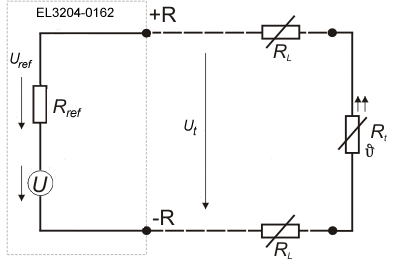2-wire connection technology
If the two-wire technique is used to connect the EL3204-0162, the terminal is connected via a two-core cable, whose internal resistance RL is connected in series with the resistance sensor Rt (fig. Two-wire connection technique with internal compensation in the terminal). The addition of these resistances causes a systematically increased temperature display, making compensation necessary. The compensation is performed internally in the terminal by the object 0x8000:1B / 0x8010:1B. Here the line resistance can be set with a resolution of 1/32 ohm.
 Fig.7: Two-conductor connection technique with internal compensation in the terminal
Fig.7: Two-conductor connection technique with internal compensation in the terminalExample:
The cross-section of the 50 meter long connecting cable made of stranded copper wire is 0.5 mm2.
The specific resistance of copper corresponds to 0.0175 Ω mm2 per meter
Determination of the total resistance of the supply line:
RLtot = 0.0175 Ω mm2 / m x (2 x 50 m / 0,5 mm2) = 3.5 Ω
For a resistance change of the Pt100 of ≈ 0.39 Ω/K , the resulting temperature deviation is:
3.5 Ω / (0.39 Ω/°C) = 8.97 °C
Compensation
In order to compensate this error, the EL3204-0162 internal circuit generally assumes a cable resistance of 10 Ω, which is set via the object 0x8000:1B / 0x8010:1B.
For the adjustment the resistance value RLtot (in the example 3.5 ohm) is entered into the index 0x8000:1B / 0x8010:1B. With a resolution of 1/32 ohm this results in a value to be entered of:
3.5 Ω / (1/32) Ω = 112dec
Further calculations for the compensation take place internally in the terminal.